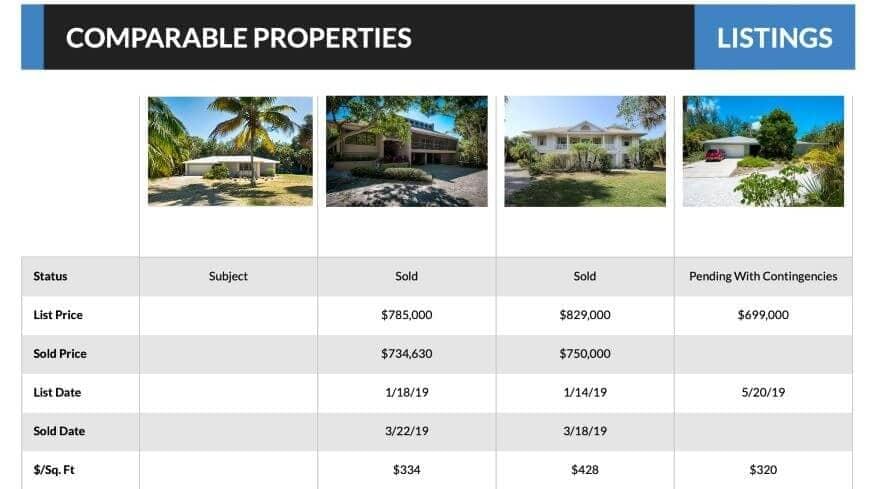What is a comparative market analysis?

A new house is a huge commitment both in terms of time and money. Given the stakes at play, it’s understandable if you feel a little cost-conscious when you’re out house hunting. How do you know the seller’s asking a fair price? And how can you avoid overspending on a piece of real estate?
It’s always a good idea to conduct your own market research so you know what a reasonable listing price looks like and can recognize a good deal when you see it. A comparative market analysis (CMA) may be able to help in that regard. Although created for the seller’s benefit, CMA real estate reports use real-world comparisons to evaluate a home’s value and set a price that ideally matches the market rate for similar properties.
Whether you’re looking to buy a new home or considering selling your own house, familiarizing yourself with CMAs is a worthwhile exercise. You’ll know what criteria real estate agents use to judge the market value of a piece of property as well as some common CMA inaccuracies to look out for in these reports.
What is a CMA in real estate?
If you’ve worked with a real estate agent in the past — either as a buyer or seller — then you’ve no doubt heard them refer to “comps” in your area. “Comps” are short for comparable homes, and more than any other single factor, they determine a home’s asking price.
CMA real estate definition
A comparative market analysis (CMA) is a report that compares the market value of multiple properties with similar features. Listing agents use these documents to check current housing prices when setting an asking price for a new listing. Real estate agents may also issue a new CMA if they’re considering dropping the price on a house that has sat on the market for a while.
You may see agents refer to a CMA as a competitive market analysis, but that would be a bit of a misnomer. A CMA report does not size up the competition. The goal of a CMA is to assess several recently sold homes — usually three, but it could be more — that are comparable to the original property to gauge its true market value. Key features agents look for include:
- Property location
- Number of bedrooms and bathrooms
- Home size by square footage
- Lot size
These comparisons come in handy if you’re selling your property and want to get a good sense of your home’s value. Keep in mind, however, that the houses analyzed in a CMA may vary in terms of amenities. Two houses could have the same number of bathrooms, for instance, but one has a whirlpool-style bathtub while the other has a regular old tub. Agents will factor in those differences when setting an asking price, but for the sake of finding a home’s baseline market value, some of those details aren’t absolutely essential.
Why should homebuyers care about CMAs?
You may have noticed that the listing agent is usually responsible for creating a real estate CMA. As the seller’s agent, their main priority is getting the best deal possible for the current homeowner. So, why should you care about a CMA when buying a house?
The word “usually” is key here. Buyer’s agents can conduct the same real estate market analysis that a listing agent does to compare the value of similar homes in the area. But it’s not a routine step on the purchase side, so you’ll have to ask for a CMA. If you have your eye on one property in particular, but aren’t sure if the asking price is reasonable, a CMA can clear things up for you.
CMA realty report example: What’s included in a CMA?
CMA reports are pretty open-ended documents. Agents can pick and choose which aspects of a home they think offer the best and most accurate comparison. That being said, these are some of the most common features included in a CMA:
- Location
- Purchase date
- Sale price
- List price
- Home size
- Lot size
- Parking space
- Number of bedrooms
- Number of bathrooms
- Age
- HVAC
- HOA
- Property photos
Through the Sanibel Real Estate Guide, McCallion & McCallion Realty provides a handy example of what a CMA looks like in practice, including the type of information you might expect to see in one of these reports:

CMA vs. appraisal report: What you need to know
CMAs and home appraisals share a lot in common — most notably, their entire purpose is to determine a home’s fair market value. Both reports look at nearby comps and review similar home features (bedrooms, bathrooms, square footage, etc.) to size up a fair asking price. Given those similarities, you might think the two are interchangeable, but that’s not the case at all.
The key difference here is that CMAs are part of the listing process while appraisals are instrumental in the mortgage process. Lenders use appraisals to check that a piece of property is sufficient collateral for the loan terms requested. If the loan amount and appraised value don’t line up, then you might need to go back to the negotiating table and see if the seller will accept a lower offer. In a worst-case scenario, your lender might withdraw your loan approval altogether.
The analysis provided by a CMA is certainly useful for both sellers and buyers, but it’s not entirely essential. A homeowner could list a home and sell it without a CMA. But a home appraisal is essential. You won’t be able to get financing to buy a new house without that assessment.
How do you get a CMA?
As we noted earlier, you can always ask your real estate agent to conduct a CMA on your behalf. You’ll need to have a specific property in mind so they can pull comps in your area that fit the same conditions as the home in question.
Don’t want to wait for your agent to create a CMA and risk another homebuyer swooping in and putting in an offer? Just ask the listing agent to see their report. Their analysis isn’t top-secret information that needs to be kept under lock and key. If an agent refused to divulge that info, it could send up a red flag that the asking price doesn’t accurately reflect the property’s fair market value.
Whether your agent creates a CMA from scratch or the listing agent shares the original report, looking over that analysis will help you avoid overspending and maybe even spot a great deal when it comes along. Of course, to get the most value out of a CMA report, you’ll first need to know how much you can afford to spend on a new house.
Tips for reading a CMA: Watch out for analysis missteps
As helpful as they can be, CMAs are not the end-all, be-all for determining a home’s value. These reports are supposed to be driven by data, but there’s a fair amount of subjectivity at play when comparing properties. And listing agents can make mistakes that call into question the veracity of their comparisons. Keep an eye on these particular aspects of a CMA since they are most likely places for errors to pop up:
- Location
- Square footage
- Bathrooms
Location
Location, location, location. We’ve all heard this axiom repeated countless times, but that’s only because it’s so true. Location is the one quality of a house that you’ll never be able to change.
And while listing agents will do their best to find comps in close proximity to a home, they may not appreciate how swiftly market value can change within a short area. That’s especially true when you’re talking about urban metro areas like New York, Chicago and Boston where the difference of a mile or two will have a huge impact on property values.
Agents try to find the best comps by limiting their search parameters to certain school districts. It’s not a perfect system, by any means, but it can be a helpful way to check that properties are in comparable locations. Even so, if a listing agent is unfamiliar with the area covered by the CMA, they may not realize that one house is significantly closer to amenities like public transportation, nightlife and parks. For urban areas especially, you may want to scrutinize the location of CMA comps more closely.
Square footage
Measuring the total living space can be a great way to compare two or more homes. But this metric can also be misleading at times. For one, basements — even finished basements — are often left out of a property listing. A home could actually have more living space than another comp because it has a fully finished basement area, but that wouldn’t necessarily come through in a CMA.
The other potential issue centers around the home’s layout. Open concept is all the rage these days, and a house with that kind of layout should be able to command a higher asking price than a similar sized home with a traditional closed floor plan. But a CMA report may only focus on square footage alone, which could make for a poor comparison.
Bathrooms
Real estate agents are at the whims of past listings to glean insights into comps. They can’t look at properties themselves to get a feel for recently sold homes. And real estate listings sometimes play it fast and loose when it comes to counting bathrooms. A half bath can suddenly turn into a full bath depending on what listing you look at.
As such, a real estate agent may pull comps using inaccurate listing info. Not intentionally mind you — they just have no way of verifying the details provided in the listing. So, you could wind up with a CMA report comparing a house with two full bathrooms with a home that only has a single full bathroom along with a powder room.
In conclusion
A comparative market analysis — commonly referred to as a CMA — pulls together multiple real estate comps that offer similar features like property size, number of bedrooms and garage space. Listing agents use these reports to determine what a competitive asking price should look like on any given piece of real estate.
From a homebuyer’s perspective, CMAs provide a lot of insight into the market value of any house that’s for sale. You can use that analysis to see how the seller decided to land on their asking price and look at comparable listings to spot potential incongruities with the comps.
CMAs do not always use the most appropriate properties for comparison, though. It’s a good idea to scrutinize these reports if you feel that a home may be overpriced. Getting the best deal on a house you love can seem tricky, but that’s why we always recommend working with qualified experts who can help you find your dream home as well as secure the right financing plan for your needs.
Powered by Froala Editor




